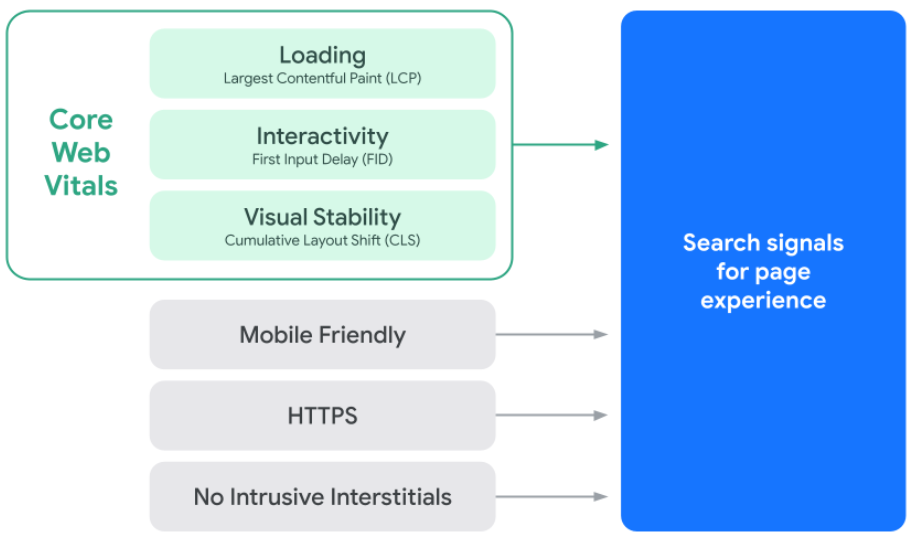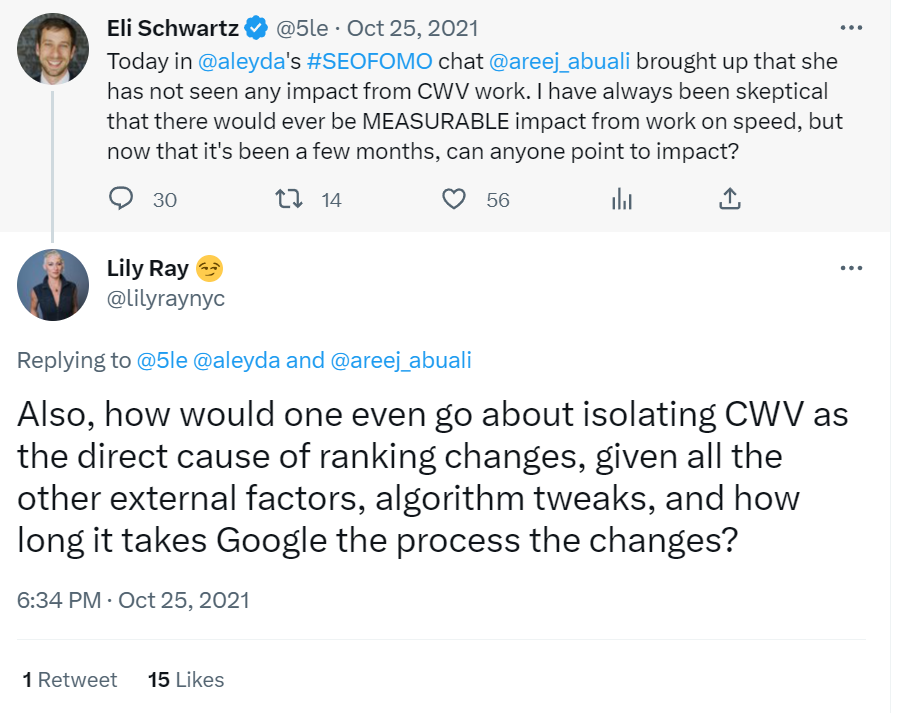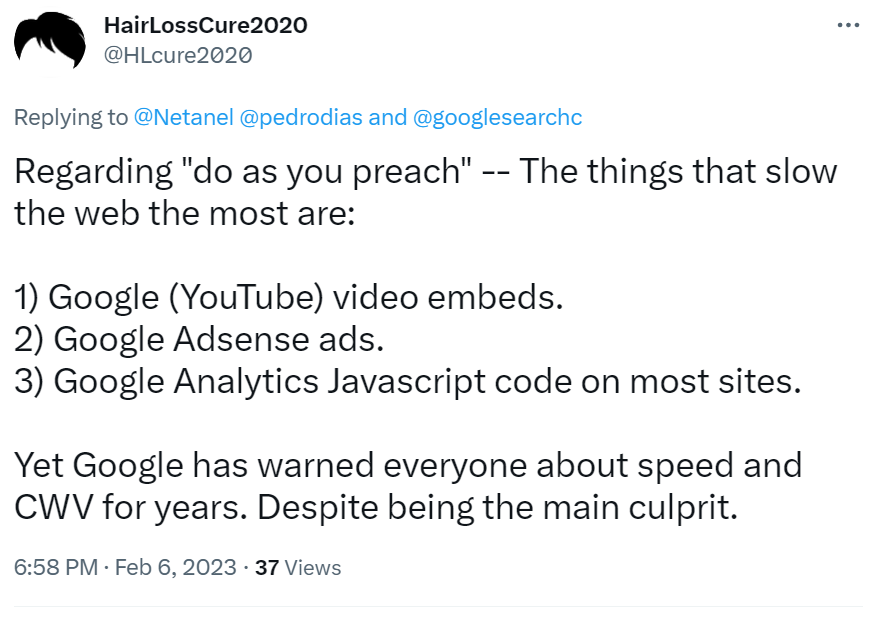When liaising with new clients, one question seems to crop up time and time again - ‘how can I improve my Core Web Vitals score?’.
There is a common preconception (fueled by Google several years back) that a high CWV score is key to ranking success. However, the reality is that going in full throttle pursuit of a high or perfect score may not only have little or no impact on your rankings, but actually do more harm than good, causing other ranking factors to suffer as a result.
In this article, I’m going to look at four different topics which will bring into question the importance of CWV in the grand scheme of things:
- Is chasing a high CWV score worth the effort?
- What impact does it have on SEO?
- The Ad Issue
- The Tracking Issue
- The Brand Issue
Ready? Let’s get started.
What are Core Web Vitals?
Chances are, if you’re reading this in the first place, you’re no stranger to Core Web Vitals, but it never hurts to recap.
In a nutshell, they’re a set of metrics defined by Google to measure a website’s loading speed, interactivity and visual stability. These metrics are broken down into the following main sections (alongside a few others):
- LCP (largest contentful paint): The amount of time taken for the largest content to appear on screen. A load time of 2.5 seconds or less is considered good.
- FID (first input delay): measures how long it takes for the website to respond when a user first clicks on something. A speed of under 200 milliseconds is considered good.
- CLS (cumulative layout shift): measures the visual stability of a page (i.e. whether or not the content jumps around as the user scrolls through the page). A score of under 0.1 is good.

Is chasing a high CWV score worth the effort?
[SPOILER ALERT: Brace yourself…this is going to be the classic ‘it depends’ answer.]
Google and the SEO industry certainly played a blinder when it came to promoting CWV as a big thing, but despite the initial drum-banging, Google itself has since confirmed a high CWV score isn’t the be all and end all for scaling the SERPs:
So just because your website is faster with regards to Core Web Vitals than some competitors doesn’t necessarily mean that come May you will jump to position number one in the search results
So, straight from the horse's mouth, we know a high CWV score won’t jump your rankings. It’s also worth highlighting that having a high score DOES NOT equate to a good user experience. Of course, site speed is important but there is so much more to crafting a great UX for your audience.
Ask yourself this: will a couple of milliseconds shaved off your loading time mean more to your audience than engaging, well-optimised content on a simple-to-navigate website? Obviously not.
While CWV is important for B2C sites, its relevance plays a lesser role for non-ecommerce sites where the main focus is geared towards quality of content and use of multimedia elements, rather than on technical performance. If we have to choose, then it’s always content that gets the priority over technical tick boxes.
That said, we’ve got to remember Google likes to keep us on our toes, shifting goalposts and tinkering with metrics / algorithms. The current iteration of CWV has evolved over the last two years and will continue to do so suggesting that at some point Google *may* add more metrics under the CWV umbrella. Therefore, to dismiss the relevance of technical performance altogether won’t serve you well for any future ‘TA-DAH!’ announcements from the Mothership.
Is improving CWV worth it for SEO?
Google wants to give users on its platform a great experience (happy users = more money) and has rolled out update after update to ensure this happens. One recent update involved bundling up existing Google search ranking factors, such as mobile-friendliness, page speed and secure connections (https), and rebranding them under the shiny new moniker page experience (as demonstrated in the image from Google below), firstly for mobile devices in August 2021, and then for desktop devices in March 2022.

Page experience is a key focus for Google, for the reasons (money) mentioned above. As a result they’ve pushed it via their own toolset including Google Search Console. The Page Experience tab has been added to show impressions and visibility of ‘good’ pages, like the example below:

The relationship between SEO and CWV, however, is far from black and white. Yes, a collaboration exists, but is there concrete evidence to show that a poor CWV score actually affects rankings? And where do these metrics fit into Google’s vast and complex algorithm for determining rankings?
Most SEOs will tell you the greatest impact they see on traffic and ranking comes from strong, relevant content, on-page optimisation, topical and unique page titles, etc., with CWV carrying marginal weight in comparison.
Yet time and time again, clients come to us with the perception that a low Core Web Vitals score is part of the reason for their low position on the SERPs, and a higher score will subsequently lead to an uplift in ranking / traffic…yet there is evidently little to quantify / back this up.

Who knows? Maybe this will all become clearer over time and it’s a case of ‘watch this space!’. It’s certainly something we’ll be keeping a close eye on over the next year or so.
All of this is reminiscent of the SEO confusion that happened for many years around the meta keywords tag. Back in the 2010s, probably the #1 question I got was ‘to improve my rankings, don’t I just add meta keywords?’ Cue two minute answer why that wasn’t the case. It seems that Core Web Vitals is following a similar path. Sigh.
The Ad Issue
Ads can throw a real spanner in the works when it comes to your CWV score. While ads play a crucial role in generating revenue, they also have notoriously large code chunks that can really put the brakes on your site's loading time…not great for CWV. That’s why striking the right balance between ad revenue and site speed is crucial. Sadly, there's no universal solution - there are too many variables involved to make your ads work optimally for your site's speed. By all means, aim for a good score, but as soon as that works to the detriment of your ad revenue, that’s when it’s time to consider whether it was worth the sacrifice.

The Tracking Issue
The reality is there’s only so much you can do to a CWV score if you have third party tracking on your site. The presence of tracking tools such as cookies and analytics will inevitably have a negative impact on CWV, slowing down loading time, increasing the file size and affecting other elements, including images and videos.
But obviously you can’t ditch these tools as this is where you collect highly valuable visitor data and analyse user behaviour which feeds into your marketing, advertising, retargeting and A/B testing strategies.
Our advice is to look at your CWV score without tracking code on to highlight a ‘true’ score and then see how it changes once all of your code is loaded on. Often there are some big changes to how things are viewed by Google (even though they are often a big culprit themselves!) but it’s important to see these in context of the bigger picture.
So similar to the Ad issue, you have to decide whether a final high CWV score is worth sacrificing your site’s tracking tools for….and I know what my answer would be.
The Brand Issue
It’s finally worth noting that Google's sole purpose is to give users the best information they can as quickly as possible. If someone searches for a particular brand, they are obligated to give that brand to the user. There are almost no exceptions (none that I can think of anyway) where a website with a rubbish CWV score would not show up for their own brand. It’s not in the user's - and therefore search engine's - best interest to see anything but the website for that brand. With so many websites generating so much traffic on their brand terms (and not much else), many websites can, and probably should, prioritise the ‘brand experience’ online over any low priority ranking signals like CWV. Obviously it goes without saying that users do like fast loading websites, but at the same time when brand is involved, we’re big advocates of pushing the boat out to wow people versus getting an image to load 0.4 milliseconds quicker.
Conclusion
While Core Web Vitals are an important part of website performance and user experience, they do not dictate or define ranking success.
Website owners should not focus solely on pursuing a higher score, but instead take a holistic approach to improving their site's overall performance and user experience. This includes considering a wide range of factors, such as the quality of the website's content, its design and usability, and its relevance to the search query.
To put it candidly, if you really want to chase that perfect score, you’re going to need to invest a heck of a lot of time and money into making it happen - time and money which could be better spent elsewhere.
The best approach in my opinion?
Keep a balanced perspective and don’t put achieving a perfect CWV score front and centre of your web marketing strategy - you’ve got bigger fish to fry.




